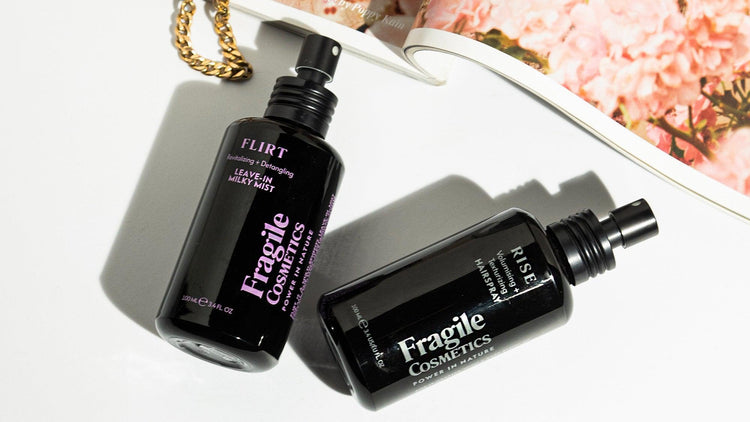Discover them:
Proteins and sulfur amino acids
Why does my hair need it?
Our hair is actually keratinized rods, that is to say that it is essentially composed of a protein called: keratin. It is itself formed of chains of amino acids, some of which are sulfurous, such as cysteine, cystine and methionine. Even if it is not the most abundant in the chemical composition of hair, sulfur is one of the most important elements. This is particularly because it is involved in the production of the "bridges" that connect these famous chains of amino acids and ensure the resistance of our hair fiber. In short, long live protein!
In which foods can you find it?
Animal proteins (meat, fish, seafood).
Plant proteins (nuts, legumes, whole grains).
If you are vegetarian or even vegan, make sure to vary the contents of your plates to find all your essential amino acids in your menus. Sulfur amino acids, like methionine, which is a component of our hair, tend to be a little rarer in the plant kingdom.
Eggs are a very interesting source, as are offal (liver, kidneys). You will also find it in alliums (garlic, onion, leek) and cruciferous vegetables (cabbage), which naturally contain sulfur compounds.
✨The bonus to consolidate my contributions
The Hair & Scalp Boost food supplement from the Aime brand. It contains rice proteins and L-methionine. Swallow 2 capsules per day during a meal (not on an empty stomach, this is important!) for a minimum of 3 months and a maximum of 6 months. You can renew your treatment several times a year if necessary (postpartum, fine hair, root irritation, etc.).
Another option: We want a growth booster from Atelier Nubio , a formula enriched with spirulina (known to be a source of vegetable proteins and B vitamins). Swallow 2 capsules per day with a glass of water for at least 3 months.
Vitamins, especially B vitamins
Why does my hair need it?
Our hair needs many vitamins to maintain a healthy appearance. Among them: vitamin A (and carotenoids) as well as vitamin C , both involved in the absorption and transport of iron – a very important trace element for our hair, a deficiency often being associated with hair loss. Let us also mention vitamin E for its antioxidant properties. But the best known in terms of hair health are the B vitamins, because they play a major role in the metabolism of proteins, amino acids and lipids. Vitamin B5 (pantothenic acid) plays a key role in the growth and resistance of our hair, as do vitamin B8 (biotin) and vitamin B6 (pyridoxine). Conclusion: stock up on vitamins!
In which foods can you find it?
Vitamin A: calf liver, eel, butter, cod liver oil.
Carotenoids: carrot, tomato, cabbage, sweet potato, spinach, melon.
Vitamin C: fruits and vegetables, especially parsley, peppers and blackcurrants.
Vitamin E: butter, wheat germ, vegetable oils, seeds, nuts.
Vitamin B5: liver, eggs, mushrooms, whole grains.
Vitamin B6: dairy products, meat, poultry, eggs, fish, potatoes.
Vitamin B8: brewer's yeast, soy, oats, cauliflower, royal jelly.
✨The bonus to consolidate my contributions
Hair gummies Pousse & Volume from the In Haircare brand . They have the advantage of coming in a fun form of chewing gums reduced in sugars (and flavored with apple!). They contain in particular vitamins B5, B6, B8 (up to 1000% of the recommended intake), B9, B12, C, E. Take 2 gummies per day for at least 3 months. If you need to do an "attack treatment", you can increase the duration of the intake up to 6 months.
Another option: the skin-nails-hair food supplement from On The Wild Side , formulated among other things with rosehip powder (known to be the plant richest in vitamin C). Swallow 2 capsules every morning with a glass of water.
Minerals and trace elements: iron, copper, zinc and Co.
Why does my hair need it?
The most cited for having beautiful hair are iron , zinc and copper. Iron, as a constituent of hemoglobin, plays an essential role in the oxygenation of the cells of our hair. It is also part of the constitution of our hair, iron deficiency anemia tending to thin it. Copper participates in the normal pigmentation of the hair fiber and the prevention of white hair, because it is a co-factor of tyrosinase (the enzyme involved in the synthesis of our natural pigments). It is also a powerful antioxidant, which protects our cells from premature aging. As for zinc , because of its influence on the production of sebum, it is interesting to prevent hair loss associated with excess sebum at the roots (oily scalp).
In which foods can you find it?
Iron: red meats, black pudding, legumes (lentils), dried apricots.
Copper: oysters, mussels, soy, calf's liver, spirulina, whole grains.
Zinc: shellfish, crustaceans, wheat germ, sesame seeds, nuts.
✨The bonus to consolidate my contributions
Hair Growth & Volume capsules from the In Haircare brand . In addition to their many B vitamins, they contain zinc and selenium (in the form of sodium selenite) combined with plant extracts. Swallow 2 capsules with a glass of water every morning for 3 months.
Another option: We Want Mermaid Hair by Atelier Nubio , which comes in the form of drinkable ampoules. It is formulated with stinging nettle powder (known for its mineral and trace element content) with an antioxidant heart of cold-pressed juice.
Fatty acids: omega-3, omega-6 and omega-9
Why does my hair need it?
Several fatty acids (and in particular omega-3 ) are the anti-inflammatory shields of our body. By participating in the regulation of our body's defense processes, they promote the maintenance of a normal hair cycle.
Omega-6 , and in particular gamma-linolenic acid, contribute to hair growth by inhibiting 5-alpha reductase (conversion of testosterone into DHT, a high level of DHT being suspected of weakening the hair follicle and leading to androgenetic alopecia – baldness). Finally, omega-9 is also said to have anti-inflammatory effects. It is said to be ideal for taking care of dry and irritated scalps.
In which foods can you find it?
Omega-3: in small oily fish (as EPA and DHA) and in vegetable oils of hemp, camelina, walnut and chia (as ALA).
Omega-6: in sunflower, sesame and grape seed oils (as linoleic acid), in evening primrose and borage oils (as gamma-linoleic acid), in animal fatty products such as butter (as arachidonic acid).
Omega-9: in olive, avocado and hazelnut oils (mainly in the form of oleic acid).













